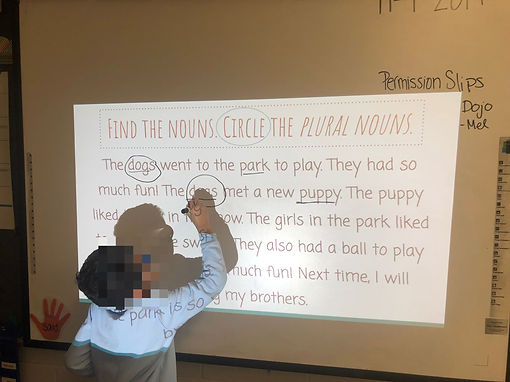Interactive Learning
Whole Group Instruction
I create all of my literacy lessons using Google Slides. I have found this format to be the most effective and engaging format to teach a variety of whole group lessons. Using Google Slides as an instructional strategy allows me to integrate visual aids, opportunities for student participation, scaffolded learning, and real life examples.
Sixteen of my 22 students are Emergent Bilingual Students. This means they speak a language other than English at home. In addition to learning basic literacy skills in my classroom, they are also learning a new language. To address the needs of these learners, I include visual aids to help students develop their vocabulary and better understand the new information or skill I am presenting.
Every day during whole group literacy instruction, I teach two new phonics, phonological awareness, or grammar skills. I use the I do, we do, you do method of instruction to ensure I explicitly teach a new skill, scaffold student’s guided practice, then give them an opportunity to try on their own. This allows students to not only develop their skills, but also help their peers learn as well.
Using google slides allows me to be more efficient when moving from one task to the next. I can easily include tasks that build on past learning to support students as they attempt a new skill. I can spark students’ past knowledge by engaging them in a previously mastered skill and set them up for success with the new learning task.
Google Slides also allows me to integrate opportunities to see how students can use the skills we are using in real life. This also allows me to include my students in the lessons. I can integrate pictures of my students or stories about my students to not only excite them and engage them in the learning, but also help them see the way they are involved in the learning.
This picture shows students adding their own words to a word family chart. Word families help students develop their phonological awareness and literacy skills. Students come to the board to add their word, then pass their marker onto another student who then comes up. This allows students to take the role of the creator of knowledge and practice the skills themselves on the board as well as keeps students engaged as they are either thinking of their own word to add while sitting on the carpet, or writing their word
on the board.


While working on plural nouns, students came to the board to identify the plural nouns in a sentence. This activity asks students to take a risk, as they are coming in front of the class and trying a new skill. Responsible risk taking is a Habit of Mind that helps students develop a growth mindset and expand their willingness to try to master new and more challenging tasks. When students make a a mistake on the board, their peers are able to correct their mistake. This helps the student at the board correct their misconceptions, as well as the students on the carpet who may have made the same mistake. When students are asked to identify the mistake in an already completed task it gives them an opportunity to practice the skill in a new way.
This video of a math whole group lesson shows a student completing a subtraction problem using the tens frame method. The student then explains his thinking. This helps him develop his metacognition Habit of Mind. This Habit of Mind helps students understand why they are doing what they are doing, which can lead to better conceptual understanding. This learning activity was helpful as during center time students completed independent work that asked them to subtract using a tens frame. The independent work also included mixed review of addition and subtraction. This students' ability to identify the minus sign as a indicator he needed to subtract will help him and his peers pay closer attention to the symbol in the equation while
working independently.